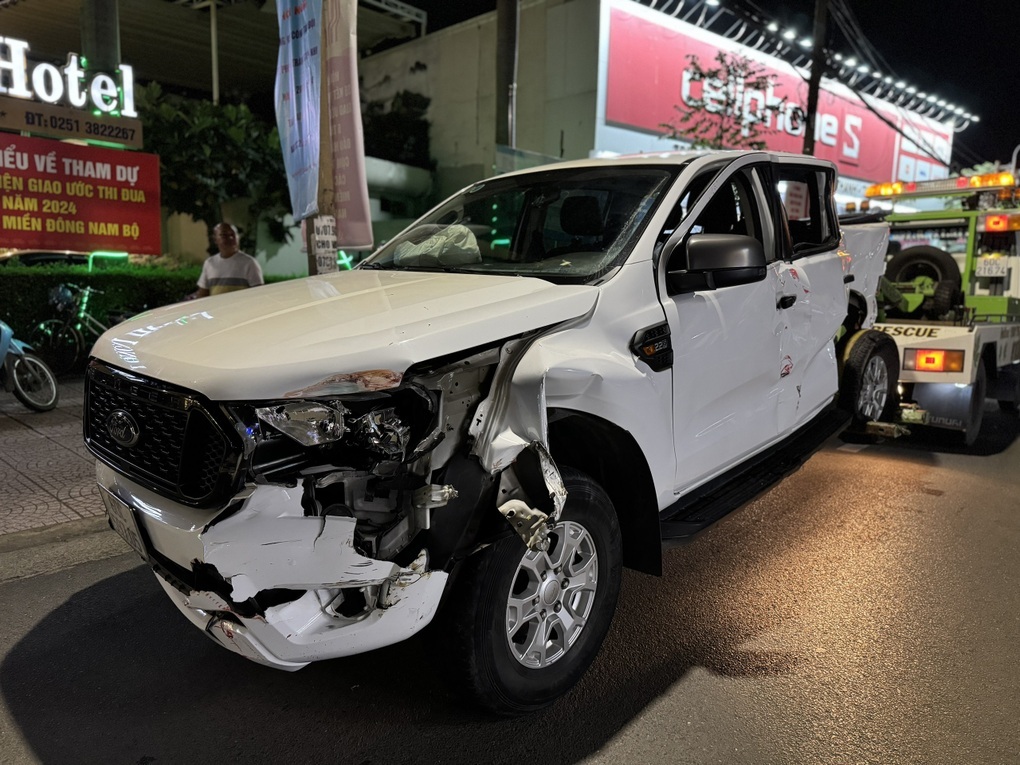
An incident occurred on the evening of July 28 at the railway crossing with Pham Van Thuan Street (Bien Hoa City, Dong Nai Province), resulting in the death of two people and serious injuries to three others.
According to initial information, the two deceased victims included a 13-year-old boy sitting behind the pickup truck and a man collecting trash. The three seriously injured individuals are currently being treated at Dong Nai General Hospital, including the pickup truck driver.
Footage from security cameras shows that despite the approaching train and the crossing guard signaling to stop, the pickup truck continued to move and crossed the railway tracks, leading to a serious collision.

After the strong collision with the train, the front part of the pickup truck was deformed, crushed, and the airbag from the driver's seat deployed (Photo: Hoang Binh).
This incident once again highlights the danger of not adhering to safety principles when participating in traffic, especially at intersections between roads and railways.
Safety rules at road-rail intersections
Article 25 of the Law on Road Traffic 2008 stipulates: On road segments intersecting at the same level with railways, bridges where roads are shared with railways, railway vehicles have the right of way.
At road-rail intersections with traffic lights, barriers, and warning bells, when the red light is on, the bell is ringing, and the barriers are closing or closed, road users must stop on their side of the road and maintain a safe distance from the barriers; when the light is off, barriers are fully open, and the bell stops ringing, only then can they proceed.
At road-rail intersections with only traffic lights or warning bells, when the red light is on or the bell is ringing, road users must immediately stop and maintain a minimum distance of 5 meters from the nearest rail; only when the light is off or the bell stops ringing can they proceed.
At road-rail intersections without traffic lights, barriers, and warning bells, road users must observe both sides, and only when ensuring no railway vehicles are approaching can they proceed. If a railway vehicle is seen approaching, they must stop and maintain a minimum distance of 5 meters from the nearest rail, and only proceed after the railway vehicle has passed.
Aside from safety rules at road-rail intersections, the incident also serves as a reminder about the importance of wearing seat belts and not carrying passengers in pickup truck beds.
Why is it necessary to wear seat belts when driving a car?
Firstly, wearing seat belts while driving a car is a legal requirement. Specifically, Article 9(2) of the Law on Road Traffic 2008 stipulates: Cars equipped with seat belts require the driver and front passengers to fasten their seat belts.
Moreover, Decree 100/2019/ND-CP, amended and supplemented by Decree 123/2021/ND-CP, imposes fines for drivers not wearing seat belts, passengers not wearing seat belts (at seats with seat belts), and for carrying passengers in a moving vehicle without seat belts.

Using fake seat belt buckles or placing the seat belt behind the back is a common practice for many people to avoid the constant beeping reminder to wear a seat belt (Photo: Reader's Digest).
Currently, many people in Vietnam still do not have the habit of wearing seat belts while driving, especially those sitting in the back seat. The reasons may include relatively light fines, which serve more as a reminder than a deterrent (ranging from 300,000 to 1 million VND), lenient enforcement of penalties, and the subjective belief that driving within a city at slow speeds may not result in serious consequences in the event of a collision...
However, the reality is that anyone can die or cause the death of others if they do not wear seat belts, whether sitting in the back or front seat.
According to a study by the Insurance Institute for Highway Safety (IIHS), wearing seat belts is essential not only for those sitting in the front seat but also for those in the back seat, as few people realize that if the backseat passengers do not wear seat belts, they can injure or even cause fatalities to front seat passengers before a collision occurs. This is because the inertia of rear seat passengers will propel them forcefully forward, pushing front seat passengers into the steering wheel, A pillar, or the front impact point, increasing the risk of more injuries.
Back in 2017, senior research engineer Jessica Jermakian from IIHS warned: "People not wearing seat belts may think their recklessness does not harm others; however, that is not true. If the backseat passengers do not wear seat belts, the risk of death in a frontal collision for the driver doubles".
Regulations on carrying passengers in cargo-carrying vehicles
Legally, except for some special cases, pickup trucks are not allowed to carry passengers in the truck bed. Specifically, Article 21 of the Law on Road Traffic 2008 states that passengers can only be carried in cargo-carrying vehicles in the following cases:
- Transporting people to perform disaster prevention and control missions or emergency tasks; transporting officers, soldiers of the People's Armed Forces on duty; transporting injured individuals for medical treatment.
- Transporting workers for road maintenance, repair; transporting people for driving practice on training vehicles; transporting participants in a parade.
- Evacuating people from dangerous areas or in other emergency cases as stipulated by law.
In addition to violating the law, carrying passengers in the bed of a pickup truck is very dangerous because the truck bed is not equipped with any specialized equipment for transporting people. In the event of a collision, when the driver brakes suddenly or the vehicle behind hits the truck, people sitting or standing in the pickup truck bed may face danger from impact, and may even be thrown out of the truck bed.
Hãy là người đầu tiên bình luận!
Bình luận: